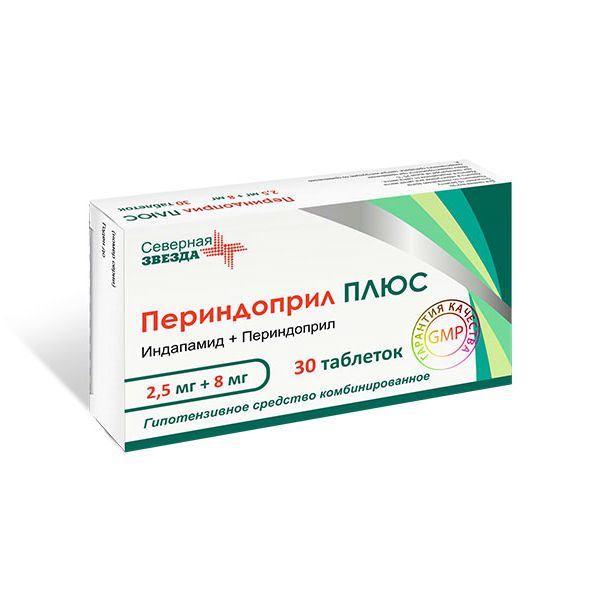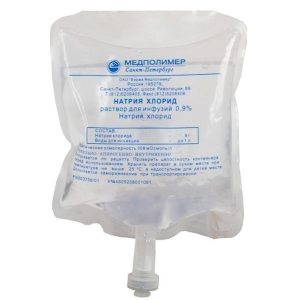Description
Pharmacological action
Drug Perindopril PLUS – a combination drug containing indapamide and perindopril erbumin. The pharmacological properties of the drug Perindopril PLUS combine the individual properties of each of its active components.
Mechanism of Action
Perindopril PLUS
The combination of indapamide and perindopril enhances the antihypertensive effect of each of them.
Perindopril
Perindopril is an inhibitor of the enzyme that converts angiotensin I to angiotensin II (an angiotensin converting enzyme (ACE) inhibitor). ACE, or kininase II, is an exopeptidase that carries out both the conversion of angiotensin I to the vasoconstrictor substance angiotensin II and the destruction of bradykinin, which has a vasodilating effect, to an inactive heptapeptide.
As a result of perindopril:
reduces the secretion of aldosterone
by the principle of negative feedback increases the activity of renin in blood plasma
with prolonged use reduces the total peripheral vascular resistance (OPSS), which is mainly due to the effect on blood vessels in muscles and kidneys. These effects are not accompanied by a delay in sodium and fluid ions or the development of reflex tachycardia.
Perindopril normalizes the myocardium, reducing preload and afterload.
When studying hemodynamic parameters in patients with chronic heart failure (CHF), it was revealed:
decreased filling pressure in the left and right ventricles of the heart
decreased OPSS
increased cardiac output and increased cardiac index
increased muscle peripheral blood flow.
Indapamide
Indapamide belongs to the group of sulfonamides, with pharmacological properties similar to thiazide diuretics.
Indapamide inhibits the reabsorption of sodium ions in the cortical segment of the Henle loop, which leads to increased excretion of sodium, chlorine and, to a lesser extent, sodium and magnesium ions by the kidneys, thereby increasing diuresis and lowering blood pressure (BP).
Antihypertensive effect
Perindopril PLUS
The drug Perindopril PLUS has a dose-dependent antihypertensive effect on both diastolic and systolic blood pressure in both standing and lying down.
Antihypertensive effect persists for 24 hours. A stable therapeutic effect develops less than 1 month after the start of therapy and is not accompanied by tachyphylaxis. Discontinuation of treatment does not cause withdrawal syndrome.
The drug Perindopril PLUS reduces the degree of left ventricular hypertrophy (LVH), improves the elasticity of arteries, reduces OPSS, does not affect the metabolism of lipids (total cholesterol, cholesterol, high density lipoproteins (HDL) and low density lipoproteins (LDL), triglycerides).
The effect of the combination of perindopril and indapamide on LVH has been proven compared to enalapril. In patients with arterial hypertension and LVH, treated with perindopril erbumin 2 mg / indapamide 0.625 mg or enalapril at a dose of 10 mg once a day, and with an increase in the dose of perindopril erbumin to 8 mg and indapamide to 2.5 mg, or enalapril to 40 mg once a day, there was a more significant decrease in the left ventricular mass index (LVMI) in the perindopril / indapamide group compared with the enalapril group. In this case, the most significant effect on LVMI is observed with the use of perindopril erbumin 8 mg / indapamide 2.5 mg.
A more pronounced antihypertensive effect was also observed against the background of combination therapy with perindopril and indapamide compared to enalapril.
Perindopril
Perindopril is effective in the treatment of hypertension of any severity. The antihypertensive effect of the drug reaches a maximum 4-6 hours after a single oral administration and persists for 24 hours. 24 hours after taking the drug, there is a pronounced (about 80%) residual inhibition of ACE.
Perindopril has an antihypertensive effect in patients with both low and normal plasma renin activity. The simultaneous administration of thiazide diuretics enhances the severity of the antihypertensive effect. In addition, the combination of an ACE inhibitor and a thiazide diuretic also reduces the risk of hypokalemia while taking diuretics.
Double blockade of the renin-angiotensin-aldosterone system (RAAS)
There are clinical trials of combination therapy using an ACE inhibitor with angiotensin II receptor antagonists (ARA II).
Clinical studies have been conducted in patients with a history of cardiovascular or cerebrovascular disease, or type 2 diabetes mellitus, accompanied by confirmed target organ damage, and studies in patients with type 2 diabetes mellitus and diabetic nephropathy.
These studies did not reveal a significant positive effect on the occurrence of renal and / or cardiovascular events and mortality rates in patients receiving combination therapy, while the risk of developing hyperkalemia, acute renal failure and / or arterial hypotension increased compared with patients receiving monotherapy.
Taking into account the similar intragroup pharmacodynamic properties of ACE inhibitors and ARA II, these results can be expected for the interaction of any other drugs, representatives of the classes of ACE inhibitors and ARA II.
Therefore, the use of ACE inhibitors in combination with angiotensin II receptor antagonists in patients with diabetic nephropathy is contraindicated.
There is evidence from a clinical study examining the beneficial effects of adding aliskiren to standard therapy with an ACE inhibitor or an ARA II in patients with type 2 diabetes and chronic kidney disease or cardiovascular disease, or with a combination of these diseases.
The study was terminated early due to the increased risk of adverse outcomes. Cardiovascular death and stroke occurred more frequently in the group of patients receiving aliskiren compared with the placebo group. Adverse events and serious adverse events of special interest (hyperkalemia, arterial hypotension, and renal dysfunction) were reported more often in the aliskiren group than in the placebo group.
Indapamide
Antihypertensive effect occurs when the drug is used in doses that have minimal diuretic effect. The antihypertensive effect of indapamide is associated with an improvement in the elastic properties of large arteries and a decrease in OPSS.
Indapamide reduces LVH, does not affect the concentration of lipids in blood plasma: triglycerides, total cholesterol, LDL, HDL carbohydrate metabolism (including in patients with concomitant diabetes mellitus).
Indications
Essential hypertension.
Contraindications
Perindopril
Hypersensitivity to perindopril and other ACE inhibitors
History of angioedema (Quincke’s edema) while taking other ACE inhibitors
Hereditary and idiopathic containing aliskiren, in patients with diabetes mellitus and / or moderate or severe impaired renal function (glomerular filtration rate (GFR) less than 60 ml / min / 1.73 m2 of body surface area.
Concomitant use with angiotensin II receptor antagonists (ARA II) in patients with diabetic nephropathy.
Under 18 years of age (efficacy and safety not established).
Indapamide
Hypersensitivity to indapamide and other sulfonamides
Moderate to severe renal failure (creatinine clearance (CC) less than 60 ml / min)
Severe hepatic insufficiency
Hepatic encephalopathy
Hypokalemia
Concomitant use with non-antiarrhythmic drugs, capable of causing polymorphic ventricular tachycardia of the pirouette type
Breastfeeding period
Age under 18 years (efficacy and safety have not been established).
Perindopril PLUS
Hypersensitivity to excipients that are part of the
drug Due to lack of sufficient clinical experience, the drug Perindopril PLUS should not be used in patients undergoing hemodialysis, as well as in patients with untreated decompensated heart failure
Under 18 years of age (efficacy and safety not established)
Lactase deficiency, galactosemia or glucose-galactose malabsorption syndrome, lactose intolerance (p eparat contains lactose).
Precautions:
Systemic diseases of the connective tissue (including systemic lupus erythematosus, scleroderma) immunosuppressive therapy (risk of neutropenia, agranulocytosis) combined use with lithium drugs, gold drugs, non-steroidal anti-inflammatory drugs (NSAIDs), baclofen, corticosteroids, drugs that can cause QT interval prolongation, drugs that can cause polymorphic ventricular tachycardia of the pirouette type, in addition to non-antiarrhythmic drugs, inhibition of bone marrow hematopoiesis uyuschey blood (diuretics, salt-free diet, vomiting, diarrhea) coronary heart disease cerebrovascular diseases impaired liver and kidney function renovascular hypertension diabetes mellitus chronic heart failure (NYHA class IV functional class) hyperuricemia (especially accompanied by gout and urate nephrolithiasis) AD lability elderly age dialysis using high-flow membranes, for example, AN ®) or desensitization, apheresis of LDL state after kidney transplantation, planned anesthesia aortic valve stenosis / g pertroficheskaya obstructive cardiomyopathy atherosclerosis blacks (a less pronounced effect on application) sportsmen (may be positive reaction in doping control), bilateral renal artery stenosis or the presence of only one functioning kidney, concomitant therapy with potassium-sparing diuretics, potassium preparations, or in patients with high plasma potassium levels.
Composition
1 tablet contains:
active ingredients:
indapamide – 2.5 mg,
perindopril erbumin – 8.0 mg
excipients: microcrystalline cellulose 102 – 141.5 mg croscarmellose sodium (6 mg primrose) pregelatinized corn starch (starch 1500) – 30.0 mg sodium bicarbonate – 8.0 mg magnesium stearate – 2, 0 mg silicon dioxide colloidal anhydrous (Aerosil anhydrous) – 2.0 mg.
Side effects
The frequency of side effects is estimated based on: often – 1-10% rarely – 0.1-1% extremely rare, including individual messages – less than 0.1%.
From the cardiovascular system: often – an excessive decrease in blood pressure and the associated symptoms, rarely – arrhythmia, angina pectoris, myocardial infarction and stroke.
From the urinary system: decreased renal function, acute renal failure.
On the part of the respiratory system: often – dry cough, difficulty breathing rarely – bronchospasm, rhinorrhea.
From the digestive system: often – nausea, vomiting, abdominal pain, taste change, diarrhea or constipation, dry mouth, decreased appetite, cholestatic jaundice, pancreatitis, intestinal edema.
From the central nervous system: often – headache, asthenia, fatigue, dizziness, ringing in the ears, visual impairment, muscle cramps, paresthesias rarely – decreased mood, insomnia extremely rare – confusion.
Allergic reactions: often – skin rash, itching rarely – urticaria, angioedema extremely rare – erythema multiforme exudative.
Laboratory indicators: often – hypercreatininemia, proteinuria, hyperkalemia, hyperuricemia rarely (with prolonged use at high doses) – neutropenia, leukopenia, hypogemoglobinemia, thrombocytopenia, extremely low hematocrit – agranulocytosis, pancytopenia, hepatic hemorrhagea, increased liver activity background deficiency of glucose-6-phosphate dehydrogenase).
Other: increased sweating, impaired sexual function.
Overdose
Symptoms: marked decrease in blood pressure, nausea, vomiting, muscle cramps, dizziness, drowsiness, confusion, oliguria up to anuria (due to a decrease in BCC), disturbances in the water-electrolyte balance are possible (low content of sodium and potassium in the blood plasma).
Treatment: gastric lavage and / or administration of activated carbon, restoration of water-electrolyte balance in a hospital. With a marked decrease in blood pressure, it is necessary to transfer the patient to supine position with legs raised up, then measures should be taken to increase the BCC (administration of a 0.9% solution of sodium chloride intravenously). Perindoprilat, an active metabolite of perindopril, can be excreted by dialysis.
Storage conditions
In the dark place at a temperature of no higher than 25 ° C.
Keep out of the reach of children.
Expiration
3 years.
Do not use after the expiration date printed on the package.
Active ingredient
Indapamide, Perindopril
Terms and conditions
prescription
dosage form
tablets



